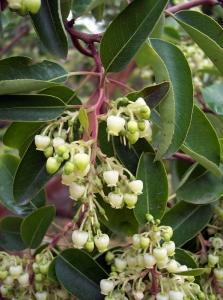Arta Prefecture Wildlife
Fauna and Flora
 One can distinguish the Arta prefecture into two major Biotope Categories: One can distinguish the Arta prefecture into two major Biotope Categories:
a. Athamanika Mountains (Tzoumerka). Here a wide variety of habitats are formed:
Coastline/rocky areas (10%, Inland cliffs),
Forest (60%, Broadleaved deciduous woodland; Mixed woodland; Native coniferous woodland),
Grassland (10%, Alpine, subalpine and boreal grassland),
Shrubland (10%, Sclerophyllous scrub, garrigue and maquis).
This is an important area for raptors and forest and scrub species as far as the fauna is concerned. The Flora is very rich, both from a biodiversity point of view, and as a percentage of the area covered by it.
Flora
The slopes of Athamanika Mountains (Mt. Tzoumerca) are blanketed with fir and pine tree forests and a large variety of perennial, deciduous or evergreen trees and bushes: Arbutus andrachne, commonly called the Greek Strawberry Tree, Arbutus unedo, commonly called Strawberry Tree or Apple of Cain, several species of Oak trees, shrubs of the genus Quercus, Wild Cherry trees of the species Prunus avium, Hazel Trees (genus Corylus: Corylus avellana, Corylus maxima, Corylus colurna called Turkish Hazel), Carob trees (Ceratonia siliqua), Basswood or Lime (Tilia species) with fragrant and nectar-producing flowers, the medicinal herb lime blossom, Sycamores (fig-mulberry trees) and more. Other plants include Orchis mascula, or Salamisri, the orchid basis for Salep production, wild mint, wild (mountain) tea, thyme, sage, savory, oregano, daffodils (orchid narcissus or Narcissus 'Thalia'), an assortment of wild Lillies (genre Lilium, many species) all add their fragrance and colors to produce the miracle that takes place every spring in our mountains.
Fauna
Mammals: Wolves (Canis lupus L), wild cats (Felis silvestris morea), deer (Cervus elaphus), bears (Ursus arctos), badgers (Eurasian badger, Meles meles), tree squirrels of the Sciuridae family, foxes (red fox, Vulpes vulpes), and hares (Lepus europaeus) are resident in the prefecture.
Birds:
resident
Alectoris graeca, Rock Partridge
Aquila chrysaetos, Golden Eagle
b. The Amvrakikos (Ambracian) Gulf. The northern section of the site is formed by the deltas of the Louros and Arachtos Rivers. It consists of brackish lagoons, a sandy coastal strip, saltmarsh, reedbeds (Phragmites), wet meadows, mudflats and remnant patches of alluvial forest. The lagoons are all used as fisheries. The Habitats formed here are also numerous: Artificial landscapes (20%, Arable land; Other urban and industrial areas; Perennial crops, orchards and groves),
Grassland (5%, Humid grasslands),
Sea/marine area (5%, Sea inlets and coastal features),
Shrubland (5%, Sclerophyllous scrub, garrigue and maquis),
Wetland (70%, Coastal lagoons; Fens, transition mires and springs; Rivers and streams; Salt marshes; Sand dunes and beaches; Standing brackish and salt water; Standing freshwater; Water fringe vegetation).
The area, as described, is a haven for birds. It is in fact an important site for wintering ducks and geese, breeding, passage and wintering raptors and migratory waders. Species of global conservation concern that do not meet IBA criteria: Phalacrocorax pygmeus (wintering), Haliaeetus albicilla (wintering), Aquila heliaca (non-breeding), Falco naumanni (passage), Gallinago media (passage). A detailed list of birds wintering, breeding, resident and passage follows (info thanks to the Hellenic Ornithological Society, member of BirdLife International):
Wintering
Anas penelope, Eurasian Wigeon
Anas clypeata, Northern Shoveler
Anas acuta, Northern Pintail
Anas crecca, Eurasian Teal
Aythya ferina, Common Pochard
Fulica atra, Common Coot
Tringa totanus, Common Redshank
Charadrius alexandrinus, Kentish Plover
Aquila clanga, Greater Spotted Eagle
Podiceps nigricollis, Black-necked Grebe
Phalacrocorax carbo, Great Cormorant
Breeding
Aythya nyroca, Ferruginous Duck
Burhinus oedicnemus, Eurasian Thick-knee
Haematopus ostralegus, Eurasian Oystercatcher
Himantopus himantopus, Black-winged Stilt
Glareola pratincola, Collared Pratincole
Sterna nilotica, Gull-billed Tern (Photo right)
Sterna albifrons, Little Tern
Chlidonias hybridus, Whiskered Tern
Casmerodius albus, Great Egret (Photo right, having caught a fish)
Ardeola ralloides, Squacco Heron
Nycticorax nycticorax, Black-crowned Night-heron
Ixobrychus minutus, Little Bittern
Platalea leucorodia, Eurasian Spoonbill
Ciconia ciconia, White Stork
Calandrella brachydactyla, Greater Short-toed Lark
Resident
Charadrius alexandrinus, Kentish Plover
Sterna sandvicensis, Sandwich Tern
Pelecanus crispus, Dalmatian Pelican
Passage
Numenius tenuirostris, Slender-billed Curlew
Calidris minuta, Little Stint
Calidris ferruginea, Curlew Sandpiper
Egretta garzetta, Little Egret
Plegadis falcinellus, Glossy Ibis |
|



